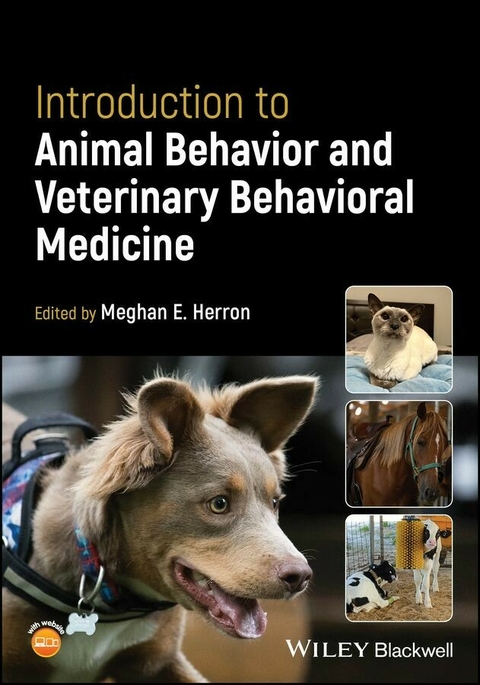
Introduction to Animal Behavior and Veterinary Behavioral Medicine
Wiley-Blackwell (Verlag)
978-1-119-82448-0 (ISBN)
Animal behavior is a critical aspect of veterinary medicine, often underappreciated despite its pervasiveness throughout the field. Understanding animal behavior can facilitate communication with patients, refine diagnoses and indications of ill health, and aid in processes of learning and socialization. »Introduction to Animal Behavior and Veterinary Behavioral Medicine« offers a comprehensive overview of the key concepts underlying the behavior of multiple animal species before demonstrating how to apply these concepts clinically, incorporating animal behavior into treatment and recovery plans. The result is an indispensable resource for veterinary students and practitioners who want to deepen their understanding of patient needs.
»Introduction to Animal Behavior and Veterinary Behavioral Medicine« readers will also find:
- Comprehensive coverage of companion animal behavior and additional coverage of livestock and wild animal behavior
- Detailed discussion of topics including social development, animal learning, applied behavior analysis and problem solving, and more
- Companion website with key images
»Introduction to Animal Behavior and Veterinary Behavioral Medicine« is ideal preparation for veterinary medical students as part of “day one readiness” in their professional careers, as well as veterinary practitioners looking for a solid foundation in animal behavior and the treatment of key issues.
Meghan E. Herron, DVM, DACVB, is a Senior Director - Behavioral Medicine Research, Education, and Outreach, at Gigi’s (Shelter for Dogs) in Ohio, USA. She is also a lecturer at The Ohio State University College of Veterinary Medicine, University of Florida College of Veterinary Medicine, Lincoln Memorial University College of Veterinary Medicine, St. Matthew’s University School of Veterinary Medicine, and Virginia Tech College of Agriculture and Life Sciences.
I. Introduction to animal behavior and handling concepts
1. Introduction – Authored by Meghan E. Herron, DVM, DACVB
An overview of animal behavior and how it applies to veterinary medicine
What shapes behavior in animals?
Genetics
Early environmental experiences
Health status
Approaches to studying behavior in animals
Ethological
Experiential
Physiological
Why is behavior relevant to veterinary medicine?
Production Animals – What behavior tells us about estrus, health status and welfare
Pet Industry – Behavior shapes the human-animal bond
Wild Animals in Captivity – How behavior is the key to welfare and successful health management in zoos and wildlife sanctuaries
Clinical Veterinary Medicine – Behavioral indicators of disease and safe animal handling
2. The Process of Domestication
How behavior shaped today’s companion and livestock species
Learn the lingo
Domesticated vs. feral
Wild vs. tamed
Natural vs. artificial selection
Traits that favor domestication – What physical and behavioral attributes made certain species more favorable for domestication and why?
The evolution of each domestic species
Domestication of dogs (Canis familiaris) – the greatest change in history and the role of neoteny
Domestication of cats (Felis catus) - how little has changed throughout history
Domestication of horses (Equus caballus) – how we had it wrong for so long
Domestication of livestock animals - chickens (Gallus gallus domesticus), cattle (Bos taurus and Bos indicus - three main factors shaped today’s cattle), pigs and sheep
3. Social Behavior
What are the benefits of group vs. solitary living?
Pairs, packs, matriarchal groups and natal bands
Social space, individual space and flight zones – how each is relevant to group housing
Social facilitation
Maternal behavior – the first social experience
Social hierarchies – What they are and why they are beneficial in group living, as well as their clinical relevance for farmers and veterinarians
Linear hierarchies – where the "pecking order" came from
Triangular, despotic and complex hierarchies
Aggression – what is aggression, what is its purpose, when is it normal?
Learn the lingo
Aggression
Agonistic behavior
Affiliative behavior
Submission
Avoidance
4. Sensory and Perception
Vision
Color vision
Monocular vs. binocular vision – benefit for predator vs. prey species
Hearing
Ranges if each species – how and why this evolved
Pinnae – the effects of size, shape and distance in between
Olfactory
Scents
Pheromones
Taste
Variance between species
Food aversion development
5. Animal Learning
Associative Learning
Classical Conditioning
What is Pavlovian conditioning and how does it apply to companion animals?
The use of classical counter-conditioning in everyday practice and in prescribed therapies
Operant Conditioning
The "four quadrants" – how they work and how they are applied
Positive reinforcement
Negative reinforcement
Positive punishment
Negative punishment
Reinforcement Schedules – what they are and how they are applied
Non-associative learning
Sensitization vs habituation
The use of desensitization and counter-conditioning in behavior modification of companion animals – putting it all together
6. The development of behavior and the shaping of the human-animal bond in companion animals: dogs
How early development shapes adult behavior, socialization vs. imprinting, setting up for success in dogs.
7. The development of behavior and the shaping of the human-animal bond in companion animals: cats
How early development shapes adult behavior, socialization vs. imprinting, setting up for success in cats.
8. The development of behavior and the shaping of the human-animal bond in companion animals: horses
How early development shapes adult behavior, socialization vs. imprinting, setting up for success in horses.
9. Bovine Communication, Restraint and Handling
Reading, interpreting and responding to bovine body language and signals of intent; safe, effective and humane restraint and handling techniques for cattle.
10. Equine Communication, Restraint and Handling
Reading, interpreting and responding to equine body language and signals of intent; safe, effective and humane restraint and handling techniques for horses.
11. Canine Communication, Restraint, and Handling
Reading, interpreting and responding to canine body language and signals of intent; safe, effective and humane restraint and handling techniques for dogs.
Feline Communication, Restraint and Handling
Reading, interpreting and responding to feline body language and signals of intent; safe, effective and humane restraint and handling techniques for cats.
II. Clinical Concepts in Animal Behavior
12. Getting Clinical – Authored by Meghan Herron, DVM, DACVB
The approach to seeing your first behavior appointment, including verbal and written history collection, medical rule outs, creating a problem and differential diagnoses list, triaging major issues and the basic structure of a treatment plan.
13. Feline Elimination Disorders
Medical considerations and work-up
Urine marking – stress related vs. territorial vs. pain-related vs. normal sexual behavior
Undesirable toileting – litterbox, substrate and location aversions vs. preferences
Feline interstitial cystitis
Approach to treatment
14. Feline Aggression
Medical considerations and work-up
Human directed aggression – making a motivation-based diagnosis, management, and treatment
Inter-cat aggression - making a motivation-based diagnosis, practical management, and treatment plan
15. Canine Aggression
What is aggression, really? How does it relate to or differ from predatory behavior?
Medical considerations and work-up
The effects of anxiety on aggressive behavior in dogs
Human directed aggression - making a motivation-based diagnosis, practical management, and treatment plan
Inter-dog aggression - making a motivation-based diagnosis, practical management, and treatment plan; what breed, age and gender pairs are at highest risk of having a poor outcome?
Leash reactivity – what motivates this behavior and how can we change it?
What about dominance?
When to consider medication to augment your plan?
16. Separation Anxiety
Definition and variations of the disorder
How to rule out other differential diagnoses and confirm separation anxiety
Approach to treatment –
Environmental enrichment, exercise, and stimulation, encouraging independence, and when to apply graduated departure plans and desensitization to departure cues
When to consider medication to augment your plan
17. Equine Aggression
Medical considerations and work-up
Human directed aggression - making a motivation-based diagnosis, practical management, and treatment plan
Inter-horse aggression – what’s normal, what isn’t, and how to manage both
18. Repetitive Behaviors in Companion Animals
Stereotypies vs. compulsive disorders – definitions and motivating factors
Medical considerations and work-up
Prevention, management, and treatment
19. Repetitive and Other Abnormal Behaviors in Captive Wild Animals
Behavior as a welfare indicator in captive wild animals
Common repetitive behaviors in zoos and wildlife sanctuaries
Medical considerations and work-up
Prevention, management, and treatment
20. Repetitive and Other Abnormal Behaviors in Livestock
Behavior as a welfare indicator in livestock animals
Common repetitive behaviors in pigs, cattle, and poultry
Medical considerations and work-up
Prevention, management, and treatment
21. Approach to Psychopharmacology in Companion Animals
When is it time to add medications to your treatment plan?
Daily medications
Indications
Classes
Mode of action, metabolism, side effects, cost considerations, known research
Event medications
Indications
Classes
Mode of action, metabolism, side effects, cost considerations, known research
22. Chemical Restraint in Companion Animals
Reducing patient distress and increasing handler safety with immediate-acting pharmacology
| Erscheinungsdatum | 30.09.2024 |
|---|---|
| Verlagsort | Hoboken |
| Sprache | englisch |
| Gewicht | 1021 g |
| Themenwelt | Veterinärmedizin ► Klinische Fächer ► Neurologie / Verhalten |
| Veterinärmedizin ► Kleintier ► Neurologie / Verhalten | |
| ISBN-10 | 1-119-82448-6 / 1119824486 |
| ISBN-13 | 978-1-119-82448-0 / 9781119824480 |
| Zustand | Neuware |
| Informationen gemäß Produktsicherheitsverordnung (GPSR) | |
| Haben Sie eine Frage zum Produkt? |
aus dem Bereich


